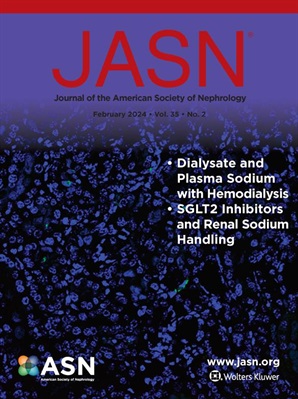Xenotransplantation: Current Understanding of the Mechanism of Immune Mediated Injury.
IF 10.3
1区 医学
Q1 UROLOGY & NEPHROLOGY
引用次数: 0
Abstract
The scarcity of transplantable organs represents a worldwide public health crisis, and as a result, thousands of people with end-stage kidney disease (ESKD) die waiting for a transplant each year. Xenotransplantation involves transplanting organs from an animal source into humans, offering a potential solution to this significant unmet need. Indeed, if there is a limitless supply of organs, many more patients who do not meet the current criteria for transplant eligibility could also be considered candidates. While there are examples of attempts to transplant animal tissues or organs into humans dating back over 300 years, none were successful due to cross-species immunologic incompatibility. Even so, significant advances in genetic engineering and the emergence of novel immunosuppressive agents have spurred impressive improvements in xenograft survival in preclinical studies involving nonhuman primates. Furthermore, recent reports of genetically modified pig kidney and heart xenotransplants in human decedents and living recipients on a compassionate use basis have provided impetus to advancing the field towards first-in-human trials. However, studies in nonhuman primates and humans thus far have described adaptive as well as innate immune-mediated xenograft injury. Understanding the mechanistic aspects of these responses at the cellular and molecular levels is critical to the development of targeted genetic modifications and innovative therapeutic strategies aimed at preventing rejection and inducing tolerance. Moreover, the physiological components of the bidirectional communication between the human host and pig xenograft must also be understood and manipulated. Here, we review the breakthroughs in renal xenotransplantation in the past few decades and highlight the immunologic hurdles that have yet to be overcome.异种移植:当前对免疫介导损伤机制的理解。
可移植器官的稀缺是一种全球性的公共卫生危机,其结果是,每年有数千名终末期肾病(ESKD)患者在等待移植时死亡。异种移植涉及将动物器官移植到人类身上,为这一重大的未满足需求提供了一个潜在的解决方案。事实上,如果器官有无限的供应,更多不符合目前移植资格标准的患者也可以被视为候选人。虽然早在300多年前就有尝试将动物组织或器官移植到人类身上的例子,但由于跨物种免疫不相容,没有一个成功。即便如此,基因工程的重大进展和新型免疫抑制剂的出现,在涉及非人灵长类动物的临床前研究中,刺激了异种移植物存活率的显著提高。此外,最近关于在人类死者和活体接受者身上进行转基因猪肾脏和心脏异种移植的报道,为推动该领域向首次人体试验的方向发展提供了动力。然而,迄今为止,对非人灵长类动物和人类的研究已经描述了适应性和先天免疫介导的异种移植物损伤。在细胞和分子水平上理解这些反应的机制方面对于开发靶向基因修饰和创新治疗策略至关重要,这些策略旨在防止排斥反应和诱导耐受。此外,人类宿主和猪异种移植物之间双向交流的生理成分也必须被理解和操纵。在这里,我们回顾了过去几十年来异种肾移植的突破,并强调了尚未克服的免疫学障碍。
本文章由计算机程序翻译,如有差异,请以英文原文为准。
求助全文
约1分钟内获得全文
求助全文
来源期刊
CiteScore
22.40
自引率
2.90%
发文量
492
审稿时长
3-8 weeks
期刊介绍:
The Journal of the American Society of Nephrology (JASN) stands as the preeminent kidney journal globally, offering an exceptional synthesis of cutting-edge basic research, clinical epidemiology, meta-analysis, and relevant editorial content. Representing a comprehensive resource, JASN encompasses clinical research, editorials distilling key findings, perspectives, and timely reviews.
Editorials are skillfully crafted to elucidate the essential insights of the parent article, while JASN actively encourages the submission of Letters to the Editor discussing recently published articles. The reviews featured in JASN are consistently erudite and comprehensive, providing thorough coverage of respective fields. Since its inception in July 1990, JASN has been a monthly publication.
JASN publishes original research reports and editorial content across a spectrum of basic and clinical science relevant to the broad discipline of nephrology. Topics covered include renal cell biology, developmental biology of the kidney, genetics of kidney disease, cell and transport physiology, hemodynamics and vascular regulation, mechanisms of blood pressure regulation, renal immunology, kidney pathology, pathophysiology of kidney diseases, nephrolithiasis, clinical nephrology (including dialysis and transplantation), and hypertension. Furthermore, articles addressing healthcare policy and care delivery issues relevant to nephrology are warmly welcomed.

 求助内容:
求助内容: 应助结果提醒方式:
应助结果提醒方式:


